
In every culture, there are mythical beings that protect people and help them to solve their problems.
These beings often take the form of winged men whom we call Guardian Angels or Ragami. In this game, each player assumes the role of a Ragami who moves around a city: the board. In this city, there are always people with problems who need help resolving their conflicts.
There are also other Ragami, Saints, and Demons that can either hinder or facilitate the conflict resolution.
Components

- One board
- 6 Conflict dice
- 3 Action dice
- 1 Power die
- 4 Virtue dice
- 33 Action cards
- 1 large cube - First-Player cube
- 30 white cubes
- 4 Resolved Conflict cubes
- 4 VP tokens
- 4 Ragamis
- 4 Saints
- 30 Location chips
- 6 Demons
- Rulebook
Object of the Game
The player who has the most Virtue Points (VPs) by end of the game wins. The game ends at the end of the round when one of the following happens:
- a player reaches 30 VP or
- location chips run out.
At the end of the last round, the player who resolved the most conflicts receives 7 more VP in addition to the VPs already col- lected. The player to resolve the second- most conflicts receives 4 extra VPs.
If there is a tie after all VPs are assigned, the player who resolved the most conflicts wins. If there is still a tie, all tied players share the victory.
Setup
-
The board represents a city with streets and city blocks. On the streets, there are dashed squares which are the places where conflicts occur. When Ragami, Saints, or Demons move through the streets, they do so in these squares.
-

A city block is an area surrounded by streets and with one building. Only a Ragami can be in a city block or move through it. Each city block has multiple adjacent areas of conflict. In the example, the city block has 6 adjacent areas (No.12, 14, 15, 18, 19 and 20).
-
Where used or discarded cards are placed.
-
Place VP tracks and Resolved Conflict cubes on zero, and place Location chips face down in players' reach. Place the white cubes and the Demons in the General Supply and the Power die on the board.
-
Roll the 6 black Conflict dice and randomly pick 1 Location chip for each conflict. Place all 6 Conflict dice and their associat- ed Location chips on the board. You should now have 6 Conflicts on 6 different locations on the board, with the matching Location chip next to each conflict die.
-
Randomly pick 4 Location chips and place 4 Demons on the board, according to the locations indicated on the chips. Each Demon should have its Location chip with it.
-
Each player must choose a color (yellow, green, blue, or pur- ple). Randomly choose the 1st player and give him the large white cube. The 2nd, 3rd and 4th players are determined clockwise.
-
Each player gets 3 Action cards, chooses ONE and discards two, placing them on the used cards zone.
-
Starting with the 1st player, each player places the Saint of his color on a location on the street (on any dashed square). At this stage, NO cubes are awarded for placing Saints in conflicts.
-

Starting with the 2nd player, each player places his Virtue die with value 1 on any city block. There may be more than one die in the same city block.
-
Starting with 3rd player, each player places his Ragami on a city block. At the start of the game, there can only be 1 Ragami per city block.
-
The 4th player (the last player) rolls the 3 Action dice.
For each red 1, the player takes a Demon from the supply (if there are any) and places it anywhere in the street. Finally, the player rotates that die to show a value of his choice (any value BUT the red 1), and places all 3 dice on the Action Table on the board.
The 1st player can now start playing the 1st round.
Round Preparation (use every round except 1st)
-

The 1st player hands over the large cube to the player on his left. This player is now the 1st Player.
-
Increase all Conflict dice on the board by 1.

Conflict Dice that would have a value of 7 are moved to the General Supply. Place a Location chip with "Ragami passage forbidden" face-up on that location. From now on, no Ragami can pass through or stay there.
Ragamis that were there are moved to an adjacent city block, chosen by the player who owns the Ragami.
-
Increase the value of the Virtue dice on the board by 1, plus the number of Ragami on that city block or in adjacent locations.


In this example, the round is ending and therefore the yellow and green dice would increase from 1 to 4 points.
- +1 point because the round is ending
- +1 for the yellow Ragami
- +1 for the purple Ragami
-

Roll all Conflict Dice in the General Supply (if there are any) and randomly pick one Location chip per each rolled dice.
Place the die and the chip on the place indicated by the location chip.
-
Players can convert the value of their Virtue die into Virtue points. Each 3 die points = 1 VP

Additionally, a player may move his die to another city block.
When moving the die, its value is changed to 1.

If a player does not have his die on the board, he may place it in any city block with the value of 1. There is no limit to the number of Virtue dice allowed in a single city block.
-

The new 4th player rolls the 3 Action dice and places them on the board.
For each red 1 on a die, the player takes one Demon from the General Supply (if there are any) and places it on any location on the street. Finally, he changes the value of those dice to any desired value BUT the red 1 value, and places them on the Action Table on the board.

In this example, the new 4th player rolled the Action dice and got a 1, a 5, and a 4. The dice with values 5 and 4 are immediately placed on the Action table, on an action of his choice.
Because of the red 1, the player takes a Demon from the supply (if there are any) and places it on the board. He then changes the die value (mandatory). He chooses the value 3. The player then places it on the remaining action area.
-
The 1stplayer starts the new round.
Round Overview
Starting with the First player and clockwise, all players perform:
One action from any Action die (see sections in green)
Any card actions that the player can and may want to do (see purple section)
The player chooses the order in which to perform the actions. He may play Action cards before and/or after using an Action die. Players do not have to perform any action, either from a die or cards.
Player 1 takes a turn, then Player 2, etc., and continue until they all pass because they either do not or cannot perform any more actions. Once all players have passed, the round ends.
Action Dice

The Action dice are placed on the Action table during the round preparation. The value of the dice indicates how many times that action can be performed during a round.
On his turn, each player may choose to take one of the 3 actions on the board, or use an Action die to move his Ragami. Once a player has used ANY of the Action dice on his turn, he is only able to take actions using Action cards. After using an Action dice, reduce the value on the dice by 1.
When a die has the value 1 (in red), it means that there is only one action left on that die. When this action is spent, the die is placed on the bottom area of the grid, showing that it cannot be used for the remainder of the round.
Some cards make an exception by allowing certain actions represented on the Action table. Players can also choose not to perform any actions.

Action Dice - Moving a Ragami

A player can ONLY move his Ragami according to certain rules:
A Ragami CANNOT be placed on the same location as a Saint with the same color. He may, however, pass between them.
A Ragami CANNOT pass through or end his movement on a location with a "Ragami passage forbidden" chip.
A Ragami may perform up to 4 movements.
A Ragami can move through streets and city blocks. He may jump from one city block to an adjacent one without passing through the street. When moving from one city block to a location on the street, that location has to be adjacent to that city block.
There can only be two Ragami on the same location on a street. There is no limit to the number of Ragamis per city block (The limit of 1 per city block exists only in the setup of the game).
If a Ragami ends his movement on a place where there are only Demons, these are removed from the board back to the supply, and the player wins 1 VP for each Demon that was in that location.

The Ragami can move to any on the places shown in yellow.
The Ragami cannot (shown in red): jump to a non-adjacent city block, end the movement on the same place of a Saint of the same color, or on the same place of a "Ragami passage forbidden" chip.

The yellow Ragami moves two spaces and finishes his movement on a location with a single Demon.
The yellow Ragami wins 1 VP removes the Demon from the board and places it back in the supply.
At the end of the round, if a Ragami is in a city block with Virtue dice, or in adjacent locations to a Virtue die, the value of the Virtue die is increased by one for each Ragami in these locations.

Action Die - Moving a Saint and Moving or Placing a new Demon

A player can move ANY Saint (any color), according to the following rules:
A Saint can ONLY move in the streets, among the dashed squares.
A Saint cannot be placed where the current player's Ragami is, but the Saint can pass through that location.
A Saint cannot be placed with another Ragami of the same color.
Each time a player places a Saint in a conflict (where a black die is), he wins 1 white cube. Important: it's not the owner of the Saint who gains the cube. It's the player who moved the Saint.
A Saint can be moved in any direction. Minimum 1 move, maximum
A Saint CANNOT end in the same place where its movement started.
After moving a Saint, the player MUST either move a Demon or place a new one on the board (choose one option), according to the following rules:
A Demon moves ONLY on streets, among the dashed squares.
Move any Demon in any direction. Minimum 1 move, maximum 4.
A Demon CANNOT end in the same place where its movement started.
If a player chooses to place a Demon taken from the game supply (if there are any), it can be placed anywhere on the street.
There is no limit to the number of Saints and Demons that can be together in the same place.

The yellow player chooses to move the Saint. He chooses to move the blue Saint to conflict 29. Because he placed a Saint on a conflict, he wins a white cube.
He would not be able to place the blue Saint on conflict 23 because his Ragami is there. He then moves the Demon from location 19 and chooses to place it on the same conflict.
Instead of moving the Demon on location 19, the player could have chosen to take a demon from the supply (if there were any) and place it directly on the location 29 conflict.
Action Die - Draw Cards

This action is only for a player to get cards. It is NOT for players to use cards. Please refer to the purple Section "Actions with cards" on page 7 to learn how you can use your cards.
When a player chooses this action, he draws 3 cards and chooses only 1.
The discarded cards are placed on the board, face-up.
A player will only be able to use the chosen card on the next turns.
A player cannot have more than 3 cards in hand. A player with 3 cards in hand can draw cards, but he will have to discard or use one of his cards first. If the draw deck runs out of cards, shuffle the cards in the discard pile (which are face-up) and place them on the board, face-down.
Action Die - Conflict Action and using Power Points

To take this action, the player must have his Ragami on a location where there is a conflict (black die).
To resolve the conflict, the Ragami must pay the same or more Power Points than those of the value of the conflict he wants
to resolve. The conflict is worth the value of the Conflict die + the number of Demons in that location. The player can get the Power Points in 6 different ways. He can use several ways simultaneously:
-
White cubes in his power. One cube = 1 Power Point.

-

Action Cards worth Power Points.
-
Saints that are on the same location as the conflict. Each Saint automatically contributes with 1 Power Point (the Saint does NOT need to give any cubes).

If the conflict is resolved, the player who owns the Saint wins 1 VP. Do not forget that a Saint and a Ragami of the same color can NOT be together at the same location.
-

If the conflict location is connected to a city block where the player has his Virtue die, he can use points from that die. He must change the value on the die, reducing its value.
If the resulting value is zero, the die is removed from the board and given back to its owner. He can only put it back on a city block at the end of the round.
-

The presence of a 2nd Ragami at the conflict location automatically contributes to the conflict resolution with 2 Power Points. The Ragami that helps receives 2 cubes from the General Supply when the conflict is resolved. Do not forget that it's not possible to have more than 2 Ragami at a conflict.
-

Using Power die. A player can use this die whenever he wants to, in order to get additional Power Points. However, once the die is used, no additional Power Points can be added from other sources.
The player rolls the Power die. If its result is higher than necessary, the remaining points are discarded and cannot be taken back.
If the conflict resolution fails (the Power die does not show enough Power Points), the player immediately withdraw his Ragami from the conflict location to an adjacent city block.
He will not lose the cubes, cards or points from Virtue die that he used to gain Power points.
When a player resolves a conflict he wins ONLY the value of the Conflict die (it doesn't matter how many Power Points the player had to use to resolve the conflict).
The black die is moved back to the supply. The Location chip remains at the location. The cards and white cubes used are returned to the General Supply.
The player adds the value of the die (and only from the die) to the Virtue point tracker and moves the cube that shows the number of resolved conflicts one space forward.

The yellow player has 6 VP and 4 resolved conflicts. He resolved another conflict of value 4. He moves his VP tracker to 10 and adds 1 point on the cube indicating the number of resolved conflicts.

To resolve this conflict, the green Ragami needs 2 Power Points. He chooses the conflict resolution action and resolves the conflict with his Virtue die, using 2 points.
He moves the black die into the supply, adds 2 VP to his score, moves his green cube forward (number of conflicts re- solved) by 1 and subtracts 2 points from his Virtue die.
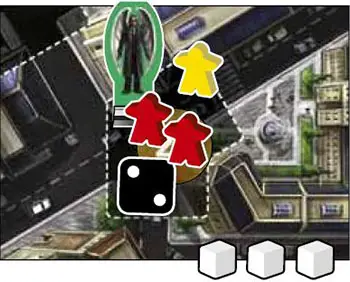
To resolve this conflict, the green Ragami needs 3 Power Points = Conflict die with value 2 + 2 Demons - 1 Saint.
He takes the conflict resolution action and resolves the conflict using 3 of his white cubes. He moves the black die into the Supply and returns his white cubes to the General Supply. He adds 2 VP to his score and moves his green cube (number of resolved conflicts) 1 space forward.
Note that the player used 3 Power Points but only got 2 VP. The yellow player gets 1 VP (because his Saint was involved in the conflict).
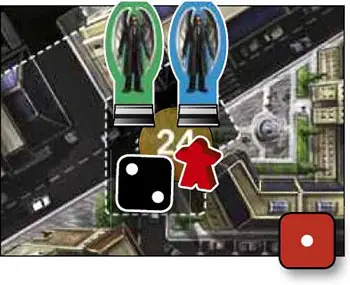
To resolve this conflict, the green Ragami needs 1 Power Point = Conflict die with value 2 + 1 Demon - 2 points (from the blue Ragami).
There's 1 point missing! He takes the risk and uses the Power die. Result is 1. It is resolved! He moves the black dice into the Supply and adds 2 VP to his score. He moves his green cube (number of resolved conflicts) 1 space forward.

The blue player gets 2 white cubes from the General Supply (because his Ragami was involved in the conflict))..
Card Actions
A player can use their cards WITHOUT using the Action die on the board. There is no limit on the number of cards that may be played during a player's turn but, in order to be played, cards must have been drawn in previous turns.
Players can use cards before and after the action from the Action die. To use the card, follow its instructions (see page 8) and place it face-up on the board in the Discarded and Used cards area.

Red triangle: when resolving a conflict, a player can use only ONE red triangle card.

White cube: this card can be turned in for a white cube instead of using its action.
Collecting VPs
A player can receive VPs in 6 different ways by:
-
Exchanging white cubes for VPs. Each 2 cubes = 1 VP. A player can perform this exchange anytime during his turn and at the end of the game.

-

Ending his Ragami's movement on a place with only Demons (no Conflict dice, nor other Ragami and Saints).
There can be several Demons, however. Demons are then "purified" and removed from the board back to the supply. The player gets 1 VP for each "purified" Demon.
-
Resolving conflicts. The player receives VPs equal to the number on the die.

-
A Saint on the location where a conflict is resolved, gives its owner 1 VP.

-

During his turn (it is not necessary to wait until the end of the round) and without spending an action, a player may convert the value of his Virtue die into VPs. Each 3 points = 1 VP.
If the die has value 3 and is decreased down to 0, the die is removed from the board and returned to the player. At the end of the round, the die can be placed on board again.
-

At the end of the game, the player with most conflicts resolved gains 7 extra VPs. The second most resolved conflicts gains 4 VPs.
The 3rd and 4th players do not have any bonus. If there is a tie, all tied players get the same value.
For example: If two players are tied for most conflicts resolved and two others for second most, the players tied for first get 7 VPs each, and the other two get 4 VPs each for being in second.
How to get White Cubes
White cubes are very important for players since they allow to resolve conflicts and to use some Action cards.
There are 3 ways of obtaining the white cubes:
-

Place Saints in conflicts.
Each time a player places a Saint (not necessarily with the player's color) in a conflict, he gets a white cube. A player cannot, however, place a Saint in a conflict in which his Ragami already is. It is also not possible to place a Saint next to a Ragami of the same color.
-

If your Ragami is involved in a conflict resolved by another Ragami.
For your help (your Ragami con- tributed with 2 Power Points), you get 2 white cubes from the General Supply,
-

Through Action cards.
There are certain cards that may give the player white cubes if certain actions are taken.
The Power Die  (optional Rule)
(optional Rule)
Players may agree not to use this die and card No. 6 to resolve conflicts.
Rules For 2 And 3 Players
For 3 players all 4 Saints start the game. The Saint that does not belong to any player is placed randomly (using a Location chip) on the board during the setup. All other rules apply.

For 2 players all 4 Saints start the game. The 2 Saints that do not belong to any player are placed randomly (using Location chips) on the board during setup. Players may also use a 3rd neutral Ragami.
This Ragami may be used by any player and can only help in conflicts. After randomly assigning the First player, both players place their pieces according to the following order: The 1st player places his Saint and Virtue die.
The 2nd player places his Saint, Virtue die, his Ragami and the neutral Ragami. Finally, the 1st player places his Ragami. The card shown here is not used in 2 player games. All other rules apply.
Cards Explanation
-

Move 2 Saints. Each Saint can move up to 4 movements.
You cannot place Saints in the same location as your Ragami. Gain 1
 for each Saint that is NOT in a conflict and moves to a conflict.
for each Saint that is NOT in a conflict and moves to a conflict. -
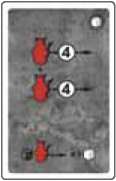
Move 2 Demons. Each Demon can move up to 4 movements.
You cannot move Demons that are on the same location as your Ragami. Gain 1
 for each Demon removed from a conflict and that does not join another conflict.
for each Demon removed from a conflict and that does not join another conflict. -

Swap the locations of your Ragami with another player's
Give 1
 of yours to the player who controls the Ragami swapped with yours.
of yours to the player who controls the Ragami swapped with yours. -
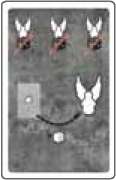
Receive 1
 for each Ragami that is not in a conflict, from the General Supply.
for each Ragami that is not in a conflict, from the General Supply.Your own RAGAMI does not count. Note: In a 2 player game, the neutral Ragami does not count.
-
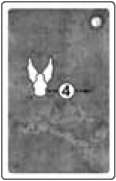
Move your Ragami up to 4 movements.
Note: In a 2 player game, the neutral Ragami can be moved with this card.
-
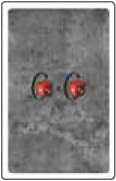
Roll the Power die twice. Add both values.
Play this card BEFORE rolling the die.
This card is always discarded whether or not the conflict has been resolved.
-
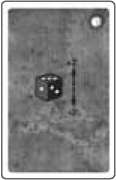
Increase the conflict die up to 2 points. or Decrease the conflict die up to 2 points.
The value of the die cannot be more than 6 or less than 1.
-
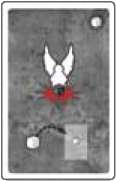
Perform a Conflict Action
Pay 1
 you own to the General Supply.
you own to the General Supply. -
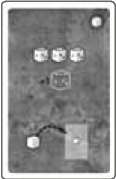
1 extra action with ONE Action die
Can be used on an action down to zero. Decrease the value of any die by 1 (if there is any left).
Pay 1
 you own to the General Supply.
you own to the General Supply. -
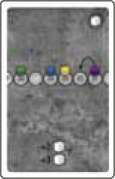
Increase the score of the last player by 1 VP and get 2

If two players are tied last, increase each one's score by 1 VP and get 3
 . If three players are tied in last, this card has no effect.
. If three players are tied in last, this card has no effect.You may not be the player in the last place or tied for last.
-

Draw 3 cards, keep 2.
You can only use this card if you only have one other card in hand besides this one.
-

Move your Virtue die from one city block to another.
Add 1 to the die's existing value. The value of the die cannot be more than 6.
-
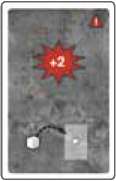
2 Power points
Pay 1
 you own to the General Supply. This card is not the Conflict Action. It just provides Power Points.
you own to the General Supply. This card is not the Conflict Action. It just provides Power Points. -
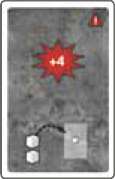
4 Power points Pay 2
 you own to the General Supply.
you own to the General Supply.This card is not the Conflict Action. It just provides Power Points.
-
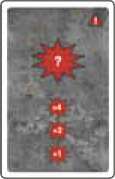
? Power Points
This card is worth 4 Power points if you are the player with fewest VPs. This card is worth 2 Power points if you are one of the players tied in last with few- This card is worth 1 Power point otherwise. This card is not the Conflict Action. It just provides Power Points.
Note: In a 2 player game, this card is not used.
Continue Reading
